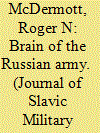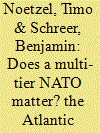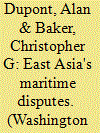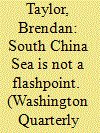|
|
|
Sort Order |
|
|
|
Items / Page
|
|
|
|
|
|
|
| Srl | Item |
| 1 |
ID:
130024


|
|
|
|
|
| Publication |
2014.
|
| Summary/Abstract |
Following the Russia-Georgia War in August 2008, Russia's conventional Armed Forces were subjected to a far reaching and unpredictable reform. Although the Armed Forces were long overdue reform, previous efforts rapidly failed for a variety of reasons including institutional inertia, in-fighting within the military elite and a lack of consensus on the goals and targets of such reform. The reforms of 2008-12 were therefore unprecedented since the creation of Russia's Armed Forces in 1992 following the disintegration of the USSR in late 1991; major changes were actually implemented. Yet, the reforms that followed were haphazard, poorly implemented and frequently experienced setbacks, reversals and an overall lack of coordinated policy efforts. These issues are examined in the following paper, exploring the roots of Russian defense planning weaknesses, and the numerous policy zigzags of the reforms to the structure of the Armed Forces, officer downsizing, NCO development and many other issues within a political-military culture that actually mitigates time-phased and fully worked-out planning cycles. Moscow's blindness to the utility of reliable military statistics will ensure continued 'blind planning' and institutional guesswork until obsessive secrecy and state level corruption give way to more scientific approaches to forming, implementing and managing such strategic level change within the country's defense and security structures.
|
|
|
|
|
|
|
|
|
|
|
|
|
|
|
|
| 2 |
ID:
086945


|
|
|
|
|
| Publication |
2009.
|
| Summary/Abstract |
This year NATO will celebrate its 60th anniversary. So far the world's most powerful military alliance has been a remarkable success story. However, as the first decade of the new century draws to a close there appears to be a widening strategic rift among the allies. 'Two-tier NATO' is by now an established piece of shorthand in international strategic debate to indicate an 'alliance à la carte' divided into two or more factions of member states with divergent interests. Evidently, the alliance increasingly struggles to reach consensus on a whole range of strategic issues. So is NATO on a path to disintegration and, ultimately, to failure? This article argues that the organization has developed from a fixed 'two-tier' into a rather fluid 'multi-tier' alliance. On many issues the alliance is in fact divided into several different camps that are pushing in different directions. Thus, allies can be grouped into one of three tiers: a 'reformist', a 'status-quo' and a 'reversal'-oriented one. While the evolution of such a multi-tier alliance will not inevitably result in NATO's demise unmanaged, this manifestation of camps will continuously disrupt the organization's strategic agility. The article finds that if NATO is to maintain strategic vitality, it needs to develop new institutional mechanisms and establish a consensus on its strategic posture in the changing international order and to make 'variable geometry' work.
|
|
|
|
|
|
|
|
|
|
|
|
|
|
|
|
| 3 |
ID:
133778


|
|
|
|
|
| Publication |
2014.
|
| Summary/Abstract |
Few doubt that China's rise is this era's principal driver of strategic change, just as the United States' equally influential ascendancy shaped the last. But earlier optimism that the Middle Kingdom's re-emergence as a major power would be largely benign is fading as evidence mounts that Beijing is determined to press its territorial and resource claims in the vitally important seas of the Western Pacific. In barely the blink of a geopolitical eye, China's once lauded charm offensive has given way to exactly the kind of coercive behavior its critics have long predicted.1 In a 3,000-mile maritime arc running from the East China Sea to the southern reaches of the South China Sea, Beijing is at loggerheads with many of its neighbors, including erstwhile friends, over several linked territorial and resource disputes. If not wisely managed, these disputes could bring East Asia's long peace to a premature and bloody end.
|
|
|
|
|
|
|
|
|
|
|
|
|
|
|
|
| 4 |
ID:
133779


|
|
|
|
|
| Publication |
2014.
|
| Summary/Abstract |
Two important anniversaries arrive in 2014 for protracted South China Sea disputes. January 19 marked 40 years since Chinese and Vietnamese forces clashed over the Paracel Islands, resulting in the deaths of more than 50 Vietnamese personnel and an undisclosed number on the Chinese side-at least the second-largest loss of life to have occurred in any single incident involving these disputed waters. Late 2014 will also mark 20 years since China controversially built structures on the aptly named Mischief Reef in the Spratly Islands, prompting a further series of incidents at sea. Recent reports that China has moved large concrete blocks to Scarborough Shoal-yet another disputed reef that was the scene of an April 2012 standoff between Chinese and Philippines vessels-have sparked concerns in Manila that history is repeating.
|
|
|
|
|
|
|
|
|
|
|
|
|
|
|
|
| 5 |
ID:
093006


|
|
|
|
|
| Publication |
2009.
|
| Summary/Abstract |
Existing literature is weak in explaining strategic change among terrorist movements, especially regarding the question of why these organizations often switch between contesting the external enemy, usually the government or the occupying power, and the internal arena in which they compete against fellow rebel groups. A rebel force facing diminishing returns from a formerly successful tactic with no equally effective tactical substitute in sight is likely to switch from conflict against a government to achieve dominance in the rebel camp. The terrorist movement will switch from the external to the internal arena even if such substitution compromises the overall goals of the rebel camp. The following article explores these dynamics in Hamas's strategy in the latest round of conflict between the movement and Israel.
|
|
|
|
|
|
|
|
|
|
|
|
|
|
|
|
|
|
|
|
|